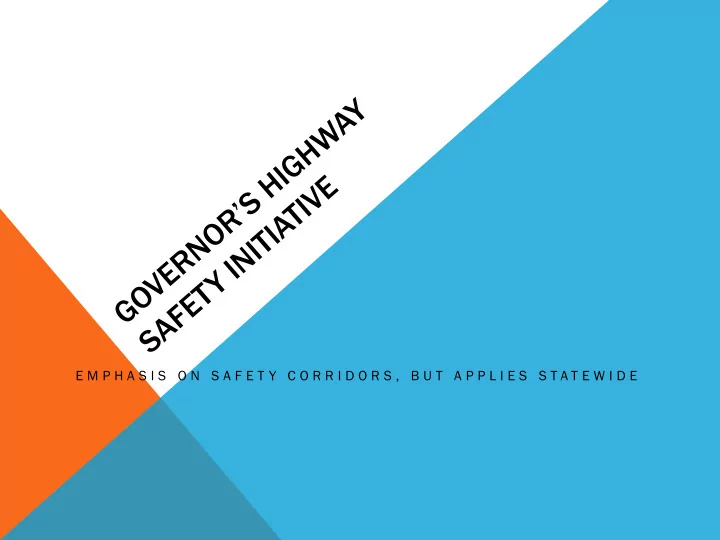

E M P H A S I S O N S A F E T Y C O R R I D O R S , B U T A P P L I E S S T A T E W I D E
PRESS RELEASE – STATE TO IMPROVE SAFETY ON ALASKA HIGHWAYS On Feb. 14 Governor Parnell and the Transportation and Public Safety Commissioners announced the “State will take significant steps to improve Alaska's highway safety corridors.” Four corridors: Parks Highway, Wasilla to Houston Seward Highway, Potter to Girdwood Sterling Highway, Soldotna to Sterling Knik-Goose Bay Road, Parks Highway to Point Makenzie Statewide serious crashes are down 53% within these corridors Mission – Reduce crash rates to zero “The Initiative establishes an Intelligent Transportation System which includes a centralized highway safety operations center, integrates real-time speed sensors, weather sensors, message boards, and avalanche detection systems, adds call boxes, and improves cell coverage.”
Emp mphasis A Areas Address 5 E’s – Enforcement, Education, Engineering, Emergency Services, & e-information Establish a Centralized Highways Traffic/Safety Operations Center Update 511 Travel Information Improve Cellular Service GOVERNOR’S HIGHWAY SAFETY INITIATIVE
Ad Addres ess 5 E’s Enfor orcement – working to establish a grant to BHP for broad traffic enforcement services Ed Education – REDDI safety messages. Advertising, such as “Drink, Drive, Go To Jail” and “Click It or Ticket. Maybe create a Safety Initiative website. Eng ngine neering ng – Increased HSIP funding. Safety corridor review recommendations; such as more VMS, brushing, passing lanes, slow vehicle turnouts, etc. Emer ergen ency Ser ervices es – Incident Response exercise identified how agencies can better work together. Add emergency call boxes in spotty cell coverage areas. e-Inf nfor ormation on – Coordinated effort of multiple agencies (ADOT&PF, DPS, EMS, ATA, etc.) to update information systems in place, such as 511 Travel Information GOVERNOR’S HIGHWAY SAFETY INITIATIVE
Establish a Centra ralized Highw hway Traffic/Safety Opera rations Center r TOC) Why hy Integrate and expand current operations center to improve internal operations, incident response and public access to real-time information. Integrate real-time travel speed sensors, cameras, weather sensors, message boards, avalanche detection systems, etc. Provide real-time information around the clock to travelers, DOT&PF personnel, law enforcement and other agencies. Eff ffort rt to to Date te Information gathering – other States, virtual or physical, existing capabilities/inventory Meet with stakeholders Develop work plan. How should we move forward with implementation GOVERNOR’S HIGHWAY SAFETY INITIATIVE
Establish a a Centra ralized H Highw hway Traffic/Safety O Opera rations Center Que uestions to to be be answe wered Practical level of infrastructure/tools to supply info to TOC? Most practical alternative for TOC – virtual or physical? Co-location possibilities? Costs – design, construction, operations, and maintenance? Priorities for Implementation? Phase I – Seward Hwy. Phase II – All other safety corridors Phase III – Other major highways statewide – Richardson, Steese, Alaska, Dalton Start with a virtual TOC that networks existing operations centers? Agree on a scope of work for a consultant to help answer the above questions? GOVERNOR’S HIGHWAY SAFETY INITIATIVE
Update 511 T Travel In Informa mation on Personalized Traveler Information – My511 Automatic Pushbuttons/Alerts Integrate Computer Aided Dispatch (CAD) systems 511 Road Warriors – enable general public to provide highway reports More frequent reporting from M&O Partner with local law enforcement More Marketing GOVERNOR’S HIGHWAY SAFETY INITIATIVE
Im Improved Cellular Service Allows travelers to access current road conditions, delays and closure information via internet and 511 traveler information system. Improves ITS communications. Contact emergency services faster. Requires partnering with cell companies. GOVERNOR’S HIGHWAY SAFETY INITIATIVE
Recommend
More recommend